批判性思维的培养(2)Critical_Thinking--Analyzing_and_Evaluating_Arguments
批判性思维的培养方法
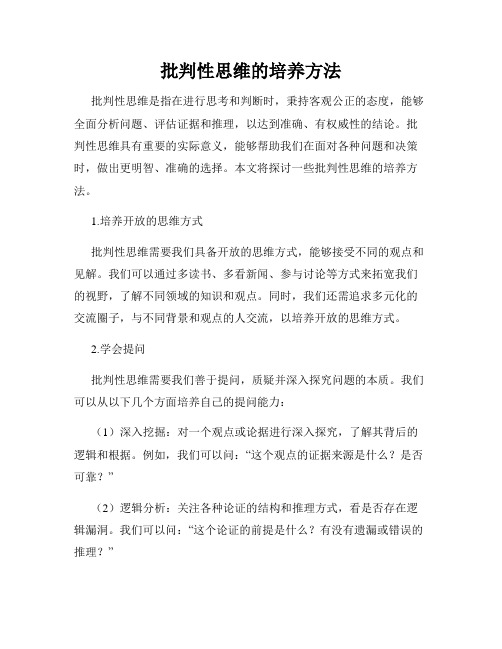
批判性思维的培养方法批判性思维是指在进行思考和判断时,秉持客观公正的态度,能够全面分析问题、评估证据和推理,以达到准确、有权威性的结论。
批判性思维具有重要的实际意义,能够帮助我们在面对各种问题和决策时,做出更明智、准确的选择。
本文将探讨一些批判性思维的培养方法。
1.培养开放的思维方式批判性思维需要我们具备开放的思维方式,能够接受不同的观点和见解。
我们可以通过多读书、多看新闻、参与讨论等方式来拓宽我们的视野,了解不同领域的知识和观点。
同时,我们还需追求多元化的交流圈子,与不同背景和观点的人交流,以培养开放的思维方式。
2.学会提问批判性思维需要我们善于提问,质疑并深入探究问题的本质。
我们可以从以下几个方面培养自己的提问能力:(1)深入挖掘:对一个观点或论据进行深入探究,了解其背后的逻辑和根据。
例如,我们可以问:“这个观点的证据来源是什么?是否可靠?”(2)逻辑分析:关注各种论证的结构和推理方式,看是否存在逻辑漏洞。
我们可以问:“这个论证的前提是什么?有没有遗漏或错误的推理?”(3)评估证据:审慎评估来自各方的证据,以确定其可靠性。
我们可以问:“这个证据有没有其他解释?是否存在潜在的偏见或利益冲突?”通过善于提问,我们能够更全面地了解问题,避免盲目接受信息,并培养批判性思维的能力。
3.分析和比较不同观点批判性思维需要我们具备分析和比较不同观点的能力。
在面对一个问题时,我们需要收集并分析不同的观点,并比较它们的优缺点、逻辑和证据的可靠性,以确定最符合事实和逻辑的观点。
通过比较不同观点,我们可以锻炼自己独立思考和判断的能力。
4.培养自我反思的习惯批判性思维需要我们能够对自己的观点、决策和思考过程进行反思和评估。
我们可以反思自己在思考问题时是否受到了个人偏见、情绪或传统观念的影响,以及自己的推理是否严密、合逻辑。
通过自我反思,我们能够不断改进自己的批判性思维,提高判断的准确性和客观性。
5.培养独立思考的能力批判性思维需要我们具备独立思考的能力,不盲从于他人观点或主流舆论。
批判性思维的培养
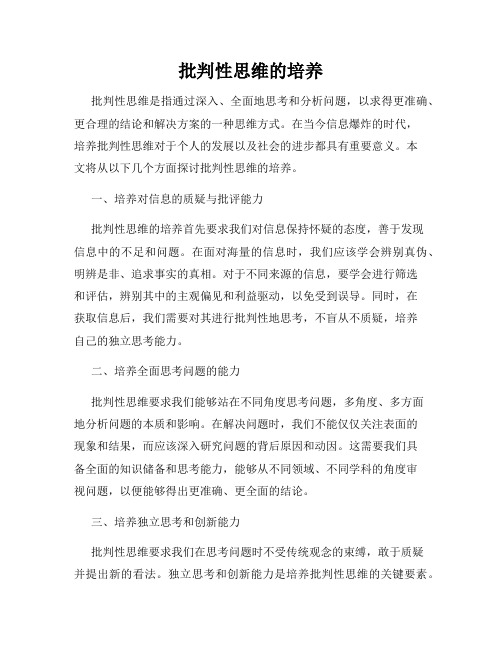
批判性思维的培养批判性思维是指通过深入、全面地思考和分析问题,以求得更准确、更合理的结论和解决方案的一种思维方式。
在当今信息爆炸的时代,培养批判性思维对于个人的发展以及社会的进步都具有重要意义。
本文将从以下几个方面探讨批判性思维的培养。
一、培养对信息的质疑与批评能力批判性思维的培养首先要求我们对信息保持怀疑的态度,善于发现信息中的不足和问题。
在面对海量的信息时,我们应该学会辨别真伪、明辨是非、追求事实的真相。
对于不同来源的信息,要学会进行筛选和评估,辨别其中的主观偏见和利益驱动,以免受到误导。
同时,在获取信息后,我们需要对其进行批判性地思考,不盲从不质疑,培养自己的独立思考能力。
二、培养全面思考问题的能力批判性思维要求我们能够站在不同角度思考问题,多角度、多方面地分析问题的本质和影响。
在解决问题时,我们不能仅仅关注表面的现象和结果,而应该深入研究问题的背后原因和动因。
这需要我们具备全面的知识储备和思考能力,能够从不同领域、不同学科的角度审视问题,以便能够得出更准确、更全面的结论。
三、培养独立思考和创新能力批判性思维要求我们在思考问题时不受传统观念的束缚,敢于质疑并提出新的看法。
独立思考和创新能力是培养批判性思维的关键要素。
我们应该将自己从众多思维框架中解脱出来,以独立思考的态度去认识世界和解决问题。
同时,我们也要鼓励他人独立思考,尊重不同观点,以推动社会的进步和发展。
四、培养逻辑与推理能力批判性思维离不开逻辑思维和推理能力的支持。
我们需要学会运用逻辑规则和推理原理,对问题进行分析和演绎。
在进行逻辑推理时,我们应该善于运用归纳和演绎两种推理方式,注意避免谬误和似是而非的推理。
通过培养逻辑与推理能力,我们能够更准确地把握问题的逻辑关系,避免在分析和判断上出现错误。
五、培养批评和反思的能力批判性思维要求我们对自己的思维和行为进行批评和反思。
我们应该主动寻找自己的盲点和不足,勇于正视自身的缺陷并进行改进。
批判性思维的培养方法
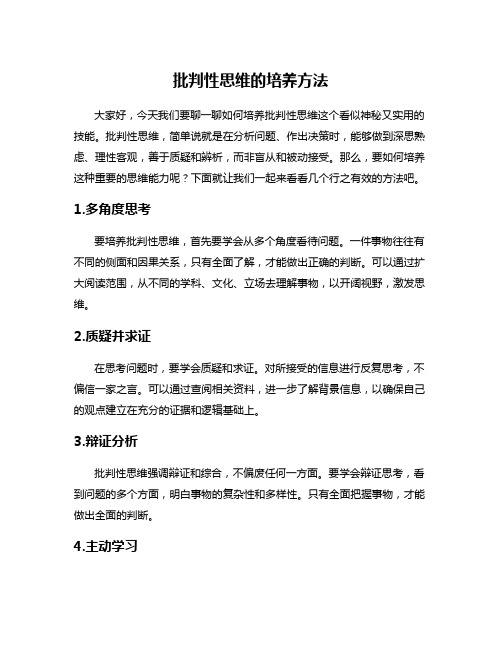
批判性思维的培养方法大家好,今天我们要聊一聊如何培养批判性思维这个看似神秘又实用的技能。
批判性思维,简单说就是在分析问题、作出决策时,能够做到深思熟虑、理性客观,善于质疑和辨析,而非盲从和被动接受。
那么,要如何培养这种重要的思维能力呢?下面就让我们一起来看看几个行之有效的方法吧。
1.多角度思考要培养批判性思维,首先要学会从多个角度看待问题。
一件事物往往有不同的侧面和因果关系,只有全面了解,才能做出正确的判断。
可以通过扩大阅读范围,从不同的学科、文化、立场去理解事物,以开阔视野,激发思维。
2.质疑并求证在思考问题时,要学会质疑和求证。
对所接受的信息进行反复思考,不偏信一家之言。
可以通过查阅相关资料,进一步了解背景信息,以确保自己的观点建立在充分的证据和逻辑基础上。
3.辩证分析批判性思维强调辩证和综合,不偏废任何一方面。
要学会辩证思考,看到问题的多个方面,明白事物的复杂性和多样性。
只有全面把握事物,才能做出全面的判断。
4.主动学习培养批判性思维需要不断学习和思考。
要保持好奇心,主动寻找问题,积极探索答案。
可以参加讨论、辩论,与他人交流观点,从中学习并改进自己的思考方式。
5.思考自我要学会思考自我。
反思自己的思维方式和偏见,认识到自己的局限性,不断完善和提升自己的思维能力。
要敢于接受挑战和失败,从中汲取经验教训,持续进步。
通过以上几点方法的不断实践和深化,我们就能逐渐培养和提升自己的批判性思维能力,成为更具思考深度和洞察力的人。
批判性思维的培养需要多角度思考、质疑求证、辩证分析、主动学习以及思考自我等一系列方法的综合运用,唯有如此,我们才能在复杂的世界中游刃有余地作出明智的选择和判断。
让我们持之以恒,不断锤炼自己的思维,成为更加睿智的人。
希望以上内容对大家有所帮助,也欢迎大家分享自己对批判性思维的见解和经验!。
批判性思维的培养

批判性思维的培养批判性思维是指个体在评价、分析和解决问题时所表现出来的思考模式。
它是一种有条理的思考方式,在人们日常生活和工作中起着不可或缺的作用。
智商和学历并不是批判性思维的保证,因为它不同于知识的积累,而是取决于个体在思考时所使用的方法。
在当今社会中,批判性思维成为了一个重要的能力。
然而,并不是每个人都能够具备这一能力。
相反,很多人通过互联网和其他渠道获取信息,却无法进行全面和准确的判断,结果只有被动地接受和相信。
因此,批判性思维的实际应用越来越受到重视。
批判性思维的特点批判性思维具有一定的特点,包括以下方面:1. 偏重于逻辑思维:批判性思维的一个重要特点是逻辑思维。
这种思考方式需要进行逻辑推理,进而得出结论。
只有通过合乎逻辑的推理,我们才能确信自己所得到的结论是准确和可靠的。
2. 较强的分析能力:批判性思维还需要具备分析能力,这种能力可以让我们对所发生的事件进行细致的分析。
我们需要表现出对细节的关注和对各种细节相关问题的深度分析,才能够做出合理的判断。
3. 批判思维:如其名所示,批判性思维的过程中充满着批判和挑战。
我们需要对所接收的任何信息进行挑战,确保我们接受和信任的内容是信任的。
通过挑战的过程,我们才能真正确定事实,并最终做出准确的判断。
4. 主动性:批判性思维的实践需要一定的主动性和独立思想。
我们需要对所看到和听到的内容进行自我解读和思考。
通过主动性思考,我们才能够分析和解决所面临的问题。
培养批判性思维的方法1. 提升知识水平:批判性思维需要建立在一定的知识基础上,因此全身心地学习各个领域的知识,才能够开展全面的批判性思维训练。
2. 反思思考方式:对于自己的思考方式进行反思,然后调整思考方式的优点,才能真正拥有批判性思维。
进行反思的方式包括或不限于表述自己的看法、进行群体讨论、和个体讨论等。
3. 不断发问:不断发问有助于培养批判性思维。
在面对问题时,不要马上认为自己已经知道了一切,而是应该不断地发问和思考,逐渐解决疑问。
如何培养批判性思维能力
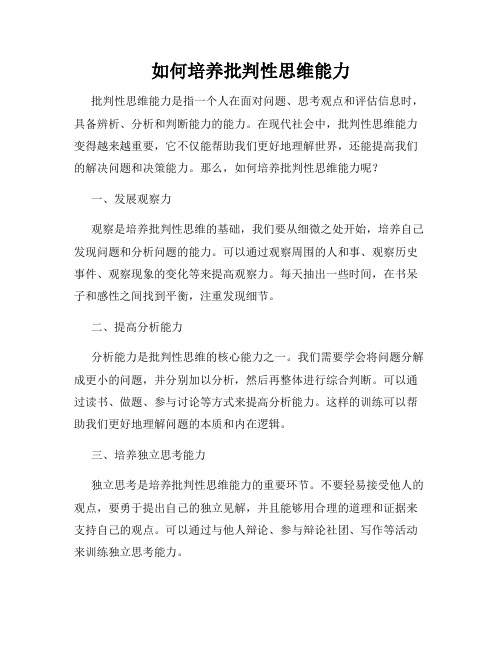
如何培养批判性思维能力批判性思维能力是指一个人在面对问题、思考观点和评估信息时,具备辨析、分析和判断能力的能力。
在现代社会中,批判性思维能力变得越来越重要,它不仅能帮助我们更好地理解世界,还能提高我们的解决问题和决策能力。
那么,如何培养批判性思维能力呢?一、发展观察力观察是培养批判性思维的基础,我们要从细微之处开始,培养自己发现问题和分析问题的能力。
可以通过观察周围的人和事、观察历史事件、观察现象的变化等来提高观察力。
每天抽出一些时间,在书呆子和感性之间找到平衡,注重发现细节。
二、提高分析能力分析能力是批判性思维的核心能力之一。
我们需要学会将问题分解成更小的问题,并分别加以分析,然后再整体进行综合判断。
可以通过读书、做题、参与讨论等方式来提高分析能力。
这样的训练可以帮助我们更好地理解问题的本质和内在逻辑。
三、培养独立思考能力独立思考是培养批判性思维能力的重要环节。
不要轻易接受他人的观点,要勇于提出自己的独立见解,并且能够用合理的道理和证据来支持自己的观点。
可以通过与他人辩论、参与辩论社团、写作等活动来训练独立思考能力。
四、学会问问题批判性思维与提问能力密不可分。
要善于提出问题,并尝试回答这些问题。
这种过程可以帮助我们去深入思考问题的本质、信息的可信度以及观点的合理性,进而培养批判性思维。
可以通过提问自己、跟他人交流和参与讨论等方式来提高提问能力。
五、拓宽知识面拓宽知识面可以帮助我们获取更多的信息和观点,从而更好地进行批判性思考。
要多读书、多看报、多关注社会热点等,通过获取不同领域的知识,形成多元化的视角和观点。
同时,要善于思考和总结,将自己的知识进行整合,形成自己的知识框架。
六、培养批判性阅读能力批判性阅读是培养批判性思维能力的重要途径。
批判性阅读不仅仅是理解与记忆,更需要我们在阅读的过程中对信息进行评估和分析,判断其可信度和合理性。
可以通过选择有深度的书籍、进行读后感分享和参与阅读俱乐部等方式来培养批判性阅读能力。
批判性思维的培养
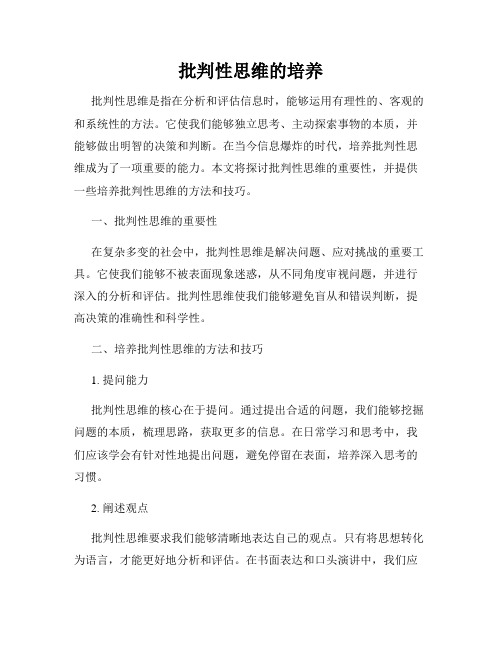
批判性思维的培养批判性思维是指在分析和评估信息时,能够运用有理性的、客观的和系统性的方法。
它使我们能够独立思考、主动探索事物的本质,并能够做出明智的决策和判断。
在当今信息爆炸的时代,培养批判性思维成为了一项重要的能力。
本文将探讨批判性思维的重要性,并提供一些培养批判性思维的方法和技巧。
一、批判性思维的重要性在复杂多变的社会中,批判性思维是解决问题、应对挑战的重要工具。
它使我们能够不被表面现象迷惑,从不同角度审视问题,并进行深入的分析和评估。
批判性思维使我们能够避免盲从和错误判断,提高决策的准确性和科学性。
二、培养批判性思维的方法和技巧1. 提问能力批判性思维的核心在于提问。
通过提出合适的问题,我们能够挖掘问题的本质,梳理思路,获取更多的信息。
在日常学习和思考中,我们应该学会有针对性地提出问题,避免停留在表面,培养深入思考的习惯。
2. 阐述观点批判性思维要求我们能够清晰地表达自己的观点。
只有将思想转化为语言,才能更好地分析和评估。
在书面表达和口头演讲中,我们应该学会用准确的词汇和条理清楚的结构来表达自己的观点,以增加别人对我们观点的理解和认同。
3. 引用证据批判性思维需要依据事实和证据进行推理和判断。
我们应该培养搜集、整理和引用证据的能力,以支持自己的观点或推翻他人的观点。
在处理争议性问题时,引用可信的证据是获取真理的重要手段。
4. 多元思考批判性思维要求我们能够从多个角度看待问题。
我们应该学会克服偏见和固定思维的局限,主动尝试不同的视角和观点。
通过多元思考,我们能够拓宽思维边界,避免主观偏见,做出更加客观和全面的判断。
5. 反思和总结批判性思维需要有对过去行为和决策的反思和总结。
我们应该学会从自己的错误中吸取教训,不断改进自己的思维方式和决策能力。
通过反思和总结,我们能够不断提高自己的批判性思维水平。
三、结语批判性思维的培养是一个需要长期坚持和不断学习的过程。
只有通过自我思考和实践,我们才能逐渐提升自己的批判性思维能力。
批判性思维的培养方法
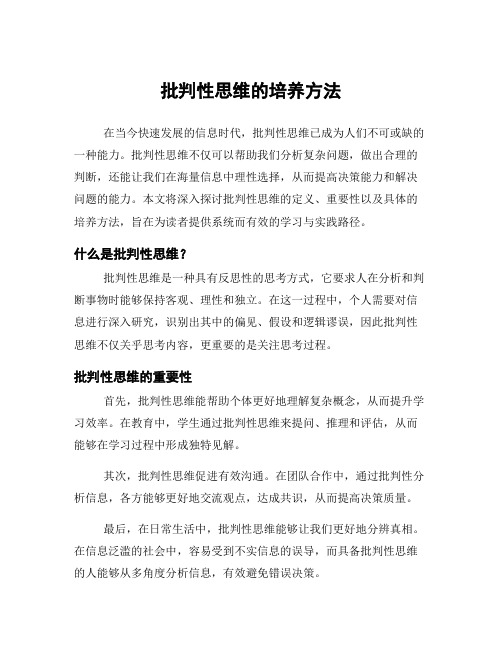
批判性思维的培养方法在当今快速发展的信息时代,批判性思维已成为人们不可或缺的一种能力。
批判性思维不仅可以帮助我们分析复杂问题,做出合理的判断,还能让我们在海量信息中理性选择,从而提高决策能力和解决问题的能力。
本文将深入探讨批判性思维的定义、重要性以及具体的培养方法,旨在为读者提供系统而有效的学习与实践路径。
什么是批判性思维?批判性思维是一种具有反思性的思考方式,它要求人在分析和判断事物时能够保持客观、理性和独立。
在这一过程中,个人需要对信息进行深入研究,识别出其中的偏见、假设和逻辑谬误,因此批判性思维不仅关乎思考内容,更重要的是关注思考过程。
批判性思维的重要性首先,批判性思维能帮助个体更好地理解复杂概念,从而提升学习效率。
在教育中,学生通过批判性思维来提问、推理和评估,从而能够在学习过程中形成独特见解。
其次,批判性思维促进有效沟通。
在团队合作中,通过批判性分析信息,各方能够更好地交流观点,达成共识,从而提高决策质量。
最后,在日常生活中,批判性思维能够让我们更好地分辨真相。
在信息泛滥的社会中,容易受到不实信息的误导,而具备批判性思维的人能够从多角度分析信息,有效避免错误决策。
培养批判性思维的方法1. 增强好奇心好奇心是激发批判性思维的第一步。
培养好奇心可以从以下几个方面着手:多问为什么:遇到问题时,多询问其原因,以此来深入理解事物的本质。
例如,当接受一项观点时,可以问:“这个观点基于什么样的假设?”或“这个结论是否经得起推敲?”探索不同领域:接触多样化的领域和学科,不仅可以扩展知识面,还能帮助我们从不同角度看待问题。
例如,科学与艺术的结合可能产生新的洞见。
2. 学会发问有效的问题是引导我们进行深入分析的关键。
要培养批判性思维,可以尝试如下练习:开放式问题:与封闭型问题相比,开放式问题能够引导个体进行更深层次的思考,例如:“这个现象背后可能有什么社会原因?”开放式问题有助于提供更多视角,让我们不拘泥于表面现象。
批判性思维的培养:培养批判性思维和分析能力

批判性思维的培养:培养批判性思维和分析能力引言人类的思维是一种非常强大的工具,它可以帮助我们理解和解决复杂的问题,也可以帮助我们做出明智的决策。
然而,并非所有的思维都是相同的,并非所有的思维都是高效的。
为了更好地应对现实生活中的挑战和问题,培养批判性思维和分析能力显得尤为重要。
本文将探讨如何培养和发展批判性思维,并提供一些实用的方法和技巧。
批判性思维的定义在开始讨论批判性思维的培养之前,我们首先需要了解批判性思维的定义。
批判性思维是一种能力,它能够帮助我们进行全面的思考、分析和评估。
它包括对信息的积极质疑和深入思考,以及对不同观点和论证的分析和评估。
批判性思维并不仅仅是接受或拒绝某些观点,而是通过逻辑性和理性来评估和判断。
批判性思维的重要性批判性思维在现代社会中显得尤为重要。
面对信息的泛滥和混乱,我们需要具备批判性思维的能力来辨别真伪和有效性。
批判性思维还可以帮助我们更好地理解复杂的问题,找到合理的解决方案。
此外,批判性思维还有助于提升个人的创造力和创新能力,因为它可以帮助我们发现问题和挑战,以及提出新的解决方案。
培养批判性思维的方法和技巧1. 开放的思维方式要培养批判性思维,首先需要保持开放的思维方式。
不要轻易接受或拒绝某些观点,而是应该问自己为什么会有这样的观点,并积极寻找相关的信息和证据来支持或反驳这些观点。
通过保持开放的思维,我们可以更好地理解复杂的问题,并找到有效的解决方案。
2. 分析和评估信息另一个培养批判性思维的方法是学会分析和评估信息。
在面对某个观点或论证时,我们应该思考它的合理性和严谨性。
这可以通过询问自己一些关键问题来实现,例如:这个观点基于什么样的证据?是否存在其他可能的解释?是否存在任何潜在的偏见或错误?通过对信息进行分析和评估,我们可以更好地理解其背后的逻辑和论据,并做出更准确的判断。
3. 持续学习和探索成为批判性思维者需要持续的学习和探索。
我们应该不断追求知识和了解新的事物。
如何培养批判性思维能力

如何培养批判性思维能力批判性思维能力是一种重要的认知能力,它能够帮助我们在面对问题时保持客观、理性的态度,并能够进行深入的思考和分析。
在现代社会中,培养批判性思维能力对于个人的学习、工作和生活都具有重要的意义。
本文将从几个方面探讨如何培养批判性思维能力。
一、培养批判性思维的重要性批判性思维是一种能够帮助我们从多个角度思考问题的能力。
它能够使我们不盲目接受信息,而是主动思考、分析和评估。
在信息爆炸的时代,我们面临着大量的信息,其中既包含真实可靠的内容,也存在着虚假的、误导性的信息。
如果缺乏批判性思维能力,我们很容易被误导,无法正确判断信息的真实性和价值。
因此,培养批判性思维能力对于个人成长和发展至关重要。
二、培养批判性思维能力的方法和技巧1. 阅读广泛:批判性思维需要建立在广泛的知识基础上。
通过阅读不同领域的书籍、文章和新闻,我们可以获得更多的信息,了解不同的观点和观念。
在阅读的过程中,我们需要保持思考,不仅仅是接受作者的观点,还要对其进行质疑和评估,从而培养批判性思维能力。
2. 思辨与推理:批判性思维需要我们具备思辨和推理的能力。
在面对问题时,我们需要学会提出质疑、分析问题的本质和因果关系,以及进行逻辑推理和演绎推理。
通过锻炼思辨与推理能力,我们可以更好地解决问题,并在日常生活中做出明智的决策。
3. 学会质疑和批评:批判性思维强调对信息和观点的质疑和批评。
我们要学会提出问题,质疑事实的真实性和观点的合理性。
通过批评和质疑,我们能够深入思考,并形成自己独立的观点。
4. 学会整合与评估:批判性思维需要我们具备整合和评估信息的能力。
在面对复杂的问题时,我们需要整合各种信息和观点,并对其进行评估和判断。
通过整合与评估,我们能够更准确地理解问题,并做出合理的判断和解决方案。
三、培养批判性思维能力的实践方法1. 反思与总结:每天结束前,反思一天的事情,总结自己的思维和行为是否具备批判性思维的特点。
思考当天遇到的问题,自己的观点和思考方式是否够理性和深入。
批判性思维的培养

批判性思维的培养在当今信息爆炸的时代,批判性思维的重要性日益凸显。
它不仅能够帮助我们在纷繁复杂的信息中辨别真伪、做出明智的决策,还能促进个人的成长和发展,提升我们的创新能力和解决问题的能力。
那么,究竟什么是批判性思维呢?批判性思维并非简单地否定或批评,而是一种理性、深入和全面的思考方式。
它要求我们对所接收到的信息进行分析、评估和质疑,不盲目接受一切观点,而是通过自己的思考和判断来形成合理的结论。
批判性思维的培养需要从多个方面入手。
首先,要学会提出问题。
当面对一个观点或信息时,我们不能仅仅被动地接受,而要主动思考,提出诸如“这是真的吗?”“为什么会这样?”“有什么证据支持?”等问题。
通过不断地提问,我们能够挖掘出信息背后的深层次逻辑和潜在的问题。
例如,在看到一则广告声称某种保健品能包治百病时,我们就应该提出疑问:这种保健品的成分是什么?有没有经过科学的临床试验?那些声称治愈的案例是否真实可信?如果不能清晰地回答这些问题,那么我们就不能轻易相信这则广告的宣传。
培养批判性思维还需要具备丰富的知识储备。
只有当我们对某个领域有一定的了解,才能更好地判断相关信息的准确性和合理性。
比如,对于医学方面的报道,如果我们对医学知识一无所知,就很难判断其中的观点是否科学。
同时,要学会多角度思考问题。
同一事物往往可以从不同的角度去看待和理解。
我们不能局限于单一的视角,而应该尝试从多个方面去分析,这样才能更全面地认识事物。
以一个社会热点事件为例,比如关于城市是否应该限制电动车出行的讨论。
支持限制的一方可能会强调电动车带来的交通混乱和安全隐患;而反对限制的一方则可能会指出电动车对于部分人群出行的便利性以及环保优势。
如果我们能够从交通管理、市民需求、环境保护等多个角度去思考这个问题,就能形成更加客观和全面的看法。
此外,我们要敢于质疑权威。
权威并不总是绝对正确的,他们的观点也可能存在局限性或错误。
但质疑权威并非是盲目地反对,而是在尊重的基础上,以理性的态度和充分的证据来提出自己的不同看法。
批判性思维的培养

批判性思维的培养引言:批判性思维的意义批判性思维是指一种理性分析、评价和判断信息的能力。
它不仅能够帮助我们更好地理解知识,还能提高我们解决问题的能力和决策的准确性。
在学习过程中,培养批判性思维显得尤为重要。
那么,如何培养批判性思维呢?培养批判性思维的方法首先,要养成独立思考的习惯。
在学习过程中,不要盲目接受他人的观点和结论,而是要通过自己的思考和分析,形成自己的见解。
例如,在阅读书籍和文章时,可以思考作者的观点是否合理,有无逻辑漏洞,并尝试提出自己的看法。
其次,要学会质疑和提问。
质疑是批判性思维的重要体现,通过提出问题,我们可以深入理解知识,发现其中的不足和矛盾。
例如,在学习历史时,可以思考历史事件的背景和原因,在学习科学时,可以质疑实验结果的准确性和可靠性。
通过不断提问和质疑,我们可以培养批判性思维,提高分析和判断能力。
另外,要多进行讨论和辩论。
讨论和辩论是培养批判性思维的有效途径。
在课堂上、学习小组中,与同学们进行讨论和辩论,可以碰撞出新的思维火花,拓宽思维视角。
例如,可以组织一次辩论赛,选择一个有争议的话题,如“科技发展对人类生活的利与弊”,通过辩论,锻炼批判性思维能力。
批判性思维在学习中的应用在学习过程中,批判性思维可以帮助我们更好地理解和掌握知识。
例如,在学习数学时,通过批判性思维,我们可以分析和解决复杂的问题,提高解题速度和准确性;在学习语文和文学时,通过批判性思维,我们可以深入理解文章的主题和作者的意图,提高阅读和写作能力;在学习科学时,通过批判性思维,我们可以分析实验结果,提出合理的解释和假设,提高科学素养。
总结:批判思维,让学习更深入批判性思维是提高学习效率和解决问题能力的重要途径。
通过养成独立思考的习惯,学会质疑和提问,多进行讨论和辩论,我们可以培养批判性思维,提高分析和判断能力。
希望每一位同学都能在学习中培养批判性思维,深入理解知识,增强学习的乐趣。
让批判性思维引领我们的学习之路,成就更好的自己。
批判性思维的培养

批判性思维的培养批判性思维是一种重要的思维能力,能够使个体在面对问题和挑战时能够有独立的见解和分析能力。
批判性思维的培养对于个人发展和社会进步都具有重要意义。
本文将探讨批判性思维的概念、培养方法以及其在日常生活和学习中的应用。
一、批判性思维的概念批判性思维是指对问题进行深入、全面的思维分析和评判的能力。
它强调理性思考、个人判断和跳脱传统观点的能力。
批判性思维不仅仅是对问题进行否定,更重要的是能够提出有建设性的批评和解决方案。
具备批判性思维的个体能够客观地看待问题,拥有独立的思考能力,不被传统观念束缚。
二、培养批判性思维的方法1. 开放思维:培养批判性思维的第一步是拥抱多元化的观点和思维方式。
通过阅读不同领域的书籍和文章,关注不同人群的意见和看法,扩大自己的知识面和视野。
了解不同观点并理解其背后的逻辑是培养批判性思维的基础。
2. 思维训练:批判性思维需要经过反复的思考和练习才能得到提升。
可以通过参与辩论、讨论小组和写作等方式进行思维训练。
这些活动能够帮助个体分析问题、提出观点并进行有效的辩论和讨论,从而培养批判性思维的能力。
3. 探索矛盾与问题:在培养批判性思维过程中,应主动发现问题和矛盾,并加以分析和解决。
矛盾和问题是思维的起点,通过深入思考和寻找解决办法,个体能够提高对问题本质的理解和解决问题的能力。
4. 反思和评估:批判性思维需要不断的自我反思和评估。
每当遇到一个新问题或者一个新观点时,个体应该通过思考和评估来判断其正确性和合理性。
定期对自己的批判性思维进行评估和修正是培养批判性思维的关键。
三、批判性思维在日常生活和学习中的应用1. 判断信息的可信度:面对日益增多的信息,批判性思维能够帮助个体判断信息的真实性和可信度。
通过分析信息的来源、作者的权威性和观点的合理性,个体能够做出客观的判断和评价,并避免受到不准确或者欺骗性信息的影响。
2. 问题解决和决策:批判性思维能够帮助个体在面对问题和决策时能够进行理性的思考和分析。
批判性思维的培养
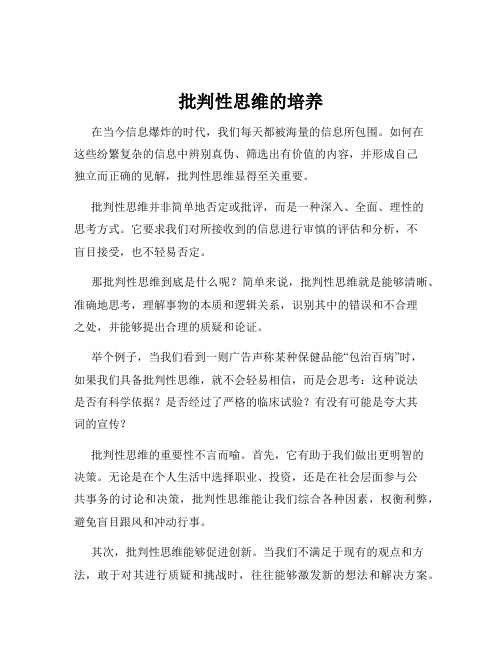
批判性思维的培养在当今信息爆炸的时代,我们每天都被海量的信息所包围。
如何在这些纷繁复杂的信息中辨别真伪、筛选出有价值的内容,并形成自己独立而正确的见解,批判性思维显得至关重要。
批判性思维并非简单地否定或批评,而是一种深入、全面、理性的思考方式。
它要求我们对所接收到的信息进行审慎的评估和分析,不盲目接受,也不轻易否定。
那批判性思维到底是什么呢?简单来说,批判性思维就是能够清晰、准确地思考,理解事物的本质和逻辑关系,识别其中的错误和不合理之处,并能够提出合理的质疑和论证。
举个例子,当我们看到一则广告声称某种保健品能“包治百病”时,如果我们具备批判性思维,就不会轻易相信,而是会思考:这种说法是否有科学依据?是否经过了严格的临床试验?有没有可能是夸大其词的宣传?批判性思维的重要性不言而喻。
首先,它有助于我们做出更明智的决策。
无论是在个人生活中选择职业、投资,还是在社会层面参与公共事务的讨论和决策,批判性思维能让我们综合各种因素,权衡利弊,避免盲目跟风和冲动行事。
其次,批判性思维能够促进创新。
当我们不满足于现有的观点和方法,敢于对其进行质疑和挑战时,往往能够激发新的想法和解决方案。
再者,批判性思维对于知识的获取和学习也有着积极的影响。
它让我们不仅仅是被动地接受知识,而是主动地去探究知识的来源、可靠性和适用范围,从而真正理解和掌握知识。
那么,如何培养批判性思维呢?培养批判性思维需要从多方面入手。
首先,我们要学会提问。
对于所接触到的信息,无论是文章、言论还是观点,都要养成多问几个“为什么”的习惯。
比如,为什么会得出这样的结论?有哪些证据支持?数据是否可靠?逻辑是否严密?通过不断地提问,我们能够深入思考,发现问题的本质。
其次,要广泛阅读和学习不同类型的知识和观点。
阅读各种学科的书籍、文章,接触不同的思想流派和观点,能够拓宽我们的视野,让我们了解到事物的多样性和复杂性。
同时,在阅读的过程中,要学会对比和分析不同观点之间的差异和优劣,从而锻炼自己的判断能力。
批判性思维的培养

批判性思维的培养在当今信息爆炸的时代,批判性思维成为了一种必不可少的能力。
它不仅能够帮助我们更好地理解世界,还能使我们在面对复杂问题时做出更为明智的决策。
本文将探讨如何培养批判性思维,以及这种思维方式对个人和社会的重要性。
首先,我们需要明确什么是批判性思维。
简而言之,批判性思维是一种理性、分析和评估的思考方式,它要求我们不断地提问、质疑和反思。
这种思维方式鼓励我们从多个角度审视问题,而不是盲目接受任何信息或观点。
那么,如何培养批判性思维呢?以下是一些实用的方法和步骤:1. 培养好奇心:对周围世界保持好奇,不断提问“为什么”和“怎样”。
好奇心是驱动我们探索未知和挑战现状的原动力。
2. 学会提问:提出有深度和开放性的问题,这些问题应该能够引导我们深入思考,而不是简单的是非题。
3. 收集信息:广泛地搜集相关信息和数据,这是进行批判性分析的基础。
确保来源的多样性和可靠性。
4. 分析和评估:对收集到的信息进行分析,识别其中的偏见、逻辑谬误和证据的强弱。
学会区分事实与意见。
5. 思考不同观点:尝试从不同的角度和立场来看待问题,这有助于我们更全面地理解情况。
6. 做出判断并反思:基于分析做出合理的判断,并准备好根据新的信息和证据调整自己的观点。
7. 练习和实践:将批判性思维应用于日常生活和学习中,无论是阅读新闻、参与讨论还是解决问题,都是锻炼的好机会。
批判性思维的重要性在于它能够帮助我们避免盲目跟风和错误决策。
在个人层面,它提高了我们的决策质量和解决问题的能力;在社会层面,它促进了知识的发展和民主的健康运作。
一个具备批判性思维的社会更能抵御虚假信息的侵害,促进公正和理性的讨论。
总之,批判性思维是一种宝贵的技能,它需要我们有意识地培养和维护。
通过不断的练习和应用,我们可以提高自己的思考质量,成为更加独立和理性的思考者。
当代高中生的批判性思维的培养

当代高中生的批判性思维的培养什么是批判性思维?批判性思维是有意识地系统地处理信息,这样就可以做出更好的决策,并且更好地理解事物。
批判性思维需要将多样化的知识工具应用到不同的信息中。
批判性思维(Critical Thinking)就是通过一定的标准评价思维,进而改善思维,是合理的、反思性的思维,既是思维技能,也是思维倾向。
最初的起源可以追溯到苏格拉底。
在现代社会,批判性思维被普遍确立为教育特别是高等教育的目标之一。
批判性思维的培养途径主要有:1.发展隐性课程,长期耳濡目染,隐性思维教育;2.设计专门课程,设置单独的批判性思维课程,进行思维训练,如开设批判性思维教程;3.把批判性思维融入到常规的教学中,结合常规课进行批判性思维训练,比如语文教学中结合听说读写的训练,同时训练学生的批判性思维能力。
至于如何在学科教学中实现对学生批判性思维能力的培养,还是一个需要实践探讨的问题。
为此我们一线语文教师可以根据自己的研究兴奋点,学习相关的理论著作和专题论文,联系实际,做较为深入细致的研讨,可以把批判性思维应用于具体的教学实践,经过长时间的提炼总结,形成阶段性的成果。
每位教师研究的切入点可以不同,可以涉及批判性思维研究的方方面面,从问题意识、思维模型、思维习得到整本书阅读、综合性实践活动等不同环节、不同方式,各有特点,百花齐放。
03语文阅读教学可选择的研究角度语文阅读教学可以选择的研究角度比较多,可以重在问题意识的培养,抓住“问题”的牛鼻子,引导学生从“问题”处进行批判性思考。
可以立足于“语言建构”与思维发展能力的培育,关注教学价值点的选择,如张广录老师曾在《语文课:基于语言建构与思维发展——以<拿来主义>教学价值点的选择为例》中,依形式逻辑同一律、矛盾律和排中律规则,对《拿来主义》的句间关系、段间关系进行过程性细读分析,并从形象思维和鲁迅语言建构特征的角度对鲁迅行文造句与营构篇章做学理释读,探究《拿来主义》最具教学价值的内容生成点。
批判性思维的培养

批判性思维的培养在当今信息爆炸的时代,批判性思维的重要性日益凸显。
它不仅有助于我们在纷繁复杂的信息中辨别真伪、做出明智的决策,还能推动个人的成长和社会的进步。
那么,什么是批判性思维?又该如何培养这种宝贵的思维能力呢?批判性思维,简单来说,就是对所接收到的信息进行深入思考、分析和评估的能力。
它要求我们不盲目接受一切观点,而是以理性、客观的态度去审视和质疑。
拥有批判性思维的人,能够清晰地理解事物的本质,发现潜在的问题和逻辑漏洞,并提出合理的解决方案。
批判性思维的培养并非一蹴而就,而是一个长期的过程。
首先,要保持好奇心和求知欲。
对周围的世界充满好奇,愿意主动去探索和了解未知的事物,这是培养批判性思维的基础。
当我们对某个问题产生疑问时,就会激发思考的动力,去寻求答案和真相。
广泛阅读是培养批判性思维的重要途径之一。
通过阅读各种类型的书籍、文章和报告,我们能够接触到不同的观点和思想。
在阅读过程中,要学会思考作者的观点是否合理,证据是否充分,论证是否严密。
对于有争议的观点,可以尝试从多个角度去分析和理解,拓宽自己的思维视野。
学会提问也是关键。
当面对一个观点或信息时,要敢于提出问题,比如“这个结论是如何得出的?”“有什么证据支持这个说法?”“是否存在其他可能的解释?”通过不断地提问,可以促使我们更深入地思考,挖掘事物背后的本质。
逻辑推理能力的培养同样不可或缺。
要学会运用逻辑规则和方法,对所接收到的信息进行分析和推理。
例如,判断因果关系是否成立,归纳和演绎推理是否合理。
通过逻辑推理,可以帮助我们发现错误的论证和不合理的结论。
另外,培养多角度思考的习惯也非常重要。
同一个问题,往往可以从不同的角度去看待和分析。
比如,对于一项政策的出台,我们可以从经济、社会、环境等多个角度去评估其影响。
多角度思考能够让我们更全面地理解问题,避免片面和狭隘的观点。
在日常生活中,我们要积极参与讨论和辩论。
与他人交流观点的过程中,能够听到不同的声音和想法,从而激发自己的思维。
批判性思维能力的培养

批判性思维能力的培养引言批判性思维能力是一种重要的认知能力,它涉及对问题进行深入分析、评估和推理的能力。
良好的批判性思维能力不仅可以帮助人们做出准确的判断和决策,还可以提高问题解决和创新能力。
本文将探讨批判性思维能力的培养方法和重要性。
培养方法以下是一些培养批判性思维能力的方法:1. 提问和探究鼓励自己和他人提出有深度的问题,挑战传统观点和假设。
通过积极探究并寻求多个观点和解释,可以培养对问题的批判性思考能力。
2. 分析和评估学会分析和评估信息的可靠性、相关性和合理性。
思考源自何处,是否有明显的偏见或利益驱动,以及是否有足够的证据来支持观点。
这可以帮助培养对信息的批判性思考和辨别能力。
3. 推理和逻辑训练自己的逻辑思维和推理能力,学会辨别合法的推理和无效的逻辑。
发展逻辑推理能力可以帮助我们从各种信息中做出正确的推断和结论。
4. 多元观点学会尊重和理解不同的观点和立场,培养接纳多元观点的能力。
通过与他人进行对话和辩论,可以拓宽自己的思维领域,提高批判性思考的能力。
重要性培养批判性思维能力对个人和社会都具有重要意义:- 个人发展:批判性思维能力可以提高自信心和独立思考能力,帮助个人更好地认识自我、掌握知识和解决问题。
- 职业发展:在工作中,批判性思维能力是一项重要的技能。
具备这种能力的人可以更好地分析和解决问题,提出创新的解决方案,并在职场中获得更好的发展机会。
- 公民素质:培养批判性思维能力可以帮助人们成为理性、公正的公民。
在信息爆炸的时代,能够独立思考并做出明智选择的人,对于社会的发展和进步有着积极的影响。
结论批判性思维能力是一种重要的认知能力,通过提问和探究、分析和评估、推理和逻辑,以及接纳多元观点,可以培养和提高这种能力。
培养批判性思维能力对个人和社会有着重要的意义,能够帮助个人在个人发展、职业发展和公民素质方面取得更好的成就。
Please note that the above response is given without any quoting or confirming sources.。
怎样培养批判性思维

怎样培养批判性思维批判性思维是指通过合理的判断、分析和解释来评价事物的思维方式。
它涉及多种高端思维技能,需要长期培养和训练。
这里介绍几点培养批判性思维的方法:首先,广泛阅读与理解不同观点。
要广泛涉猎阅读不同角度和观点的资料,理解作者观点的来源和论据依据。
在理解不同观点的同时,要对它们的论据和论证过程进行判断和评价。
这可以培养辨证和审慎的思维态度。
其次,提问与解决问题。
在学习和生活中养成不断提问的习惯,特别要对自己的观点和论据提出质疑。
同时,要努力回答和解决这些问题,通过这种质疑与辩驳的过程来推进思考。
这可以锻炼判断和分析的能力。
再次,理清思路与表达清晰。
要在思考中理清自己的逻辑与论据,判断思路的连贯性和论证的严密性。
并努力用言简意赅的语言表达清晰自己的观点和论据。
在表达清晰的同时还需要指出不足之处,这有助于进一步改进和深化思考。
此外,要在讨论中进行“思辨”。
在与他人讨论和交流中不要过快接受对方观点,要提出质疑并进行辩驳。
同时也要倾听不同意见,在争论中找出最合理的观点。
讨论可以促进思考的广度与深度,对批判性思维的养成至关重要。
最后,进行思考总结与再植入。
要养成对自己思维过程进行总结和检讨的习惯。
在每次思考的最后,要对得出的观点和论证过程进行审查,找到其中的不足与提高空间。
这有助于进一步加深对待问题的理解,也使思维模式更加系统与严密。
对上次思考的总结也要在下次思考中重新审视,这可以实现批判性思维的提高。
综上,批判性思维需要广阅理解不同观点,养成提问解决问题的习惯。
需要在思考和表达中理清逻辑,并在讨论中进行思辨。
更需要进行系统的思考总结和再植入,持续推进对问题的理解,优化思维模式。
批判性思维的培养是一个长期的过程,但它将使思维变得更加积极与主动。
如何培养批判性思维
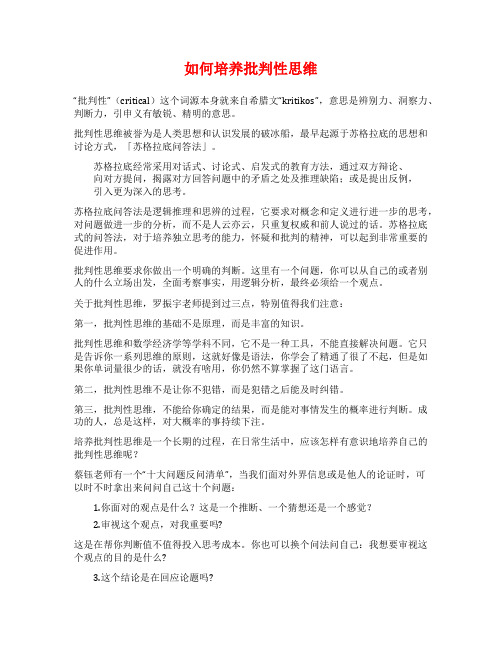
如何培养批判性思维“批判性”(critical)这个词源本身就来自希腊文“kritikos”,意思是辨别力、洞察力、判断力,引申义有敏锐、精明的意思。
批判性思维被誉为是人类思想和认识发展的破冰船,最早起源于苏格拉底的思想和讨论方式,「苏格拉底问答法」。
苏格拉底经常采用对话式、讨论式、启发式的教育方法,通过双方辩论、向对方提问,揭露对方回答问题中的矛盾之处及推理缺陷;或是提出反例,引入更为深入的思考。
苏格拉底问答法是逻辑推理和思辨的过程,它要求对概念和定义进行进一步的思考,对问题做进一步的分析,而不是人云亦云,只重复权威和前人说过的话。
苏格拉底式的问答法,对于培养独立思考的能力,怀疑和批判的精神,可以起到非常重要的促进作用。
批判性思维要求你做出一个明确的判断。
这里有一个问题,你可以从自己的或者别人的什么立场出发,全面考察事实,用逻辑分析,最终必须给一个观点。
关于批判性思维,罗振宇老师提到过三点,特别值得我们注意:第一,批判性思维的基础不是原理,而是丰富的知识。
批判性思维和数学经济学等学科不同,它不是一种工具,不能直接解决问题。
它只是告诉你一系列思维的原则,这就好像是语法,你学会了精通了很了不起,但是如果你单词量很少的话,就没有啥用,你仍然不算掌握了这门语言。
第二,批判性思维不是让你不犯错,而是犯错之后能及时纠错。
第三,批判性思维,不能给你确定的结果,而是能对事情发生的概率进行判断。
成功的人,总是这样,对大概率的事持续下注。
培养批判性思维是一个长期的过程,在日常生活中,应该怎样有意识地培养自己的批判性思维呢?蔡钰老师有一个“十大问题反问清单”,当我们面对外界信息或是他人的论证时,可以时不时拿出来问问自己这十个问题:1.你面对的观点是什么?这是一个推断、一个猜想还是一个感觉?2.审视这个观点,对我重要吗?这是在帮你判断值不值得投入思考成本。
你也可以换个问法问自己:我想要审视这个观点的目的是什么?3.这个结论是在回应论题吗?这是在帮你判断,你的论题和结论是否匹配,结论有没有偷换。
- 1、下载文档前请自行甄别文档内容的完整性,平台不提供额外的编辑、内容补充、找答案等附加服务。
- 2、"仅部分预览"的文档,不可在线预览部分如存在完整性等问题,可反馈申请退款(可完整预览的文档不适用该条件!)。
- 3、如文档侵犯您的权益,请联系客服反馈,我们会尽快为您处理(人工客服工作时间:9:00-18:30)。
The Principle of Charity
• ―When interpreting an unclear argument or passage, always give the speaker or writer the benefit of the doubt.‖ • ―Never attribute to an arguer a weaker argument when the argument permits us to attribute to him or her a stronger one.‖ • ―And never interpret a passage as a bad argument when the evidence reasonably permits us to interpret it as not an argument at all.‖
Outline of Today’s Lecture
• Part One: Deductive Arguments vs. Inductive Arguments
• Part Two: Logical Fallacies • Part Three: Analyzing Arguments
• Part Four: Evaluating Arguments
Part Two: Logical Fallacies
• Fallacies of Relevance
• Common Fallacies of Relevance • Fallacies of Insufficient Evidence • Common Fallacies of Insufficient Evidence
Outline of Lecture Series
• May 4th, 2009: Critical Thinking—An introduction • May 11th, 2009: Critical Thinking— Analyzing and Evaluating Arguments
• May 18th, 2009: Critical Thinking—Skills for Reading and Writing
Critical Thinking: Analyzing and Evaluating Arguments
Kathleen Maloney Lanzhou University May 11, 2009
Reminder:
• Authors: Greg Bassham, William Irvin, Henry Nardone, and James M. Wallace • Title: Critical Thinking: A Student’s Introduction • Location: Foreign language library, third floor of the main library.
The Principle of Charity
• ―When interpreting an unclear argument or passage, always give the speaker or writer the benefit of the doubt. Never attribute to an arguer a weaker argument when the argument permits us to attribute to him or her a stronger one. And never interpret a passage as a bad argument when the evidence reasonably permits us to interpret it as not an argument at all‖ (59).
The Principle of Charity
• Why use the Principle of Charity?
– When we are generous and respectful, we encourage others to act in the same way. – When we use the Principle of Charity, we make our opponent’s argument as strong as it can be. We improve more from confronting challenging opponents than from attacking weak ones.
If the premises are true, then the conclusion must be true.
Inductive Arguments Claim That…
If the premises are true, then the conclusion probably is true.
• Attacking the Motive: instead of analyzing and evaluating the argument on its own merit, we claim that the person making the argument is doing so for selfish reasons.
The Principle of Charity
• Inexperienced writers often treat their opponents with a high level of skepticism. • This is a terrible habit to get into. Instead we should try to remember to always follow the Principle of Charity when dealing with someone’s opposing argument.
• Some common deduction indicator words are:
Certainly Definitely Absolutely Conclusively It logically follows… It is logical to conclude… This entails that… It must be the case that…
• Thus, fallacies of relevance occur when people try to support an argument with irrelevant information.
Common Fallacies of Relevance
• Personal Attack: instead of analyzing and evaluating the argument on its own merit, we attack the quality of the person making the argument.
Probably Likely It is plausible to suppose… One would expect that…
These indicator words are quoted from Bassham, Irwin, Jones, and Wallace, Critical Thinking, page 57.
Fallacies of Relevance
• Remember from last week the importance of relevance (相关 ) in critical thinking.
• Fallacies (谬论) are false or mistaken ideas that often sound plausible but are in fact untrue or illogical.
Deductive vs. Inductive Arguments
• People often describe the difference between deductive arguments and inductive arguments in the following way:
– Deductive arguments move from general premises to particular conclusions. – Inductive arguments move from particular premises to general conclusions.
– A common inductive argument pattern is:
Things like X tend to be Y. I expect a new X. It will probably be Y.
Deductive vs. Inductive
Deductive Arguments Claim That…
All A is B. All B is C Therefore, all A is C.
Inductive Arguments
• Inductive arguments simply try to show that if their premises are true, then their conclusions are probably true.
Common Fallacies of Relevance
• Two Wrongs Make a Right: when we try to justify a wrongful act by showing that another act is just as bad or worse.
